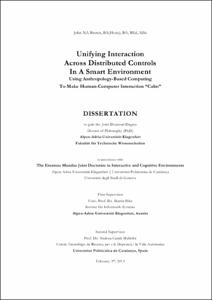Unifying interaction across distributed controls in a smart environment using anthropology-based computing to make human-computer interaction "Calm"

Visualitza/Obre
10.5821/dissertation-2117-95604
Inclou dades d'ús des de 2022
Cita com:
hdl:2117/95604
Càtedra / Departament / Institut
Escola Politècnica Superior d'Enginyeria de Vilanova i la Geltrú
Tipus de documentTesi
Data de defensa2014-04-04
EditorUniversitat Politècnica de Catalunya
Condicions d'accésAccés obert
Llevat que s'hi indiqui el contrari, els
continguts d'aquesta obra estan subjectes a la llicència de Creative Commons
:
Reconeixement-NoComercial-SenseObraDerivada 3.0 Espanya
Abstract
Rather than adapt human behavior to suit a life surrounded by computerized systems, is it possible to adapt the systems to suit humans? Mark Weiser called for this fundamental change to the design and engineering of computer systems nearly twenty years ago. We believe it is possible and offer a series of related theoretical developments and practical experiments designed in an attempt to build a system that can meet his challenge without resorting to black box design principles or Wizard of Oz protocols. This culminated in a trial involving 32 participants, each of whom used two different multimodal interactive techniques, based on our novel interaction paradigm, to intuitively control nine distributed devices in a smart home setting. The theoretical work and practical developments have led to our proposal of seven contributions to the state of the art.
Descripció
Cotutela Universitat Politècnica de Catalunya i Alpen-Adria-Universität Klagenfurt, Austria
CitacióBrown, J.N.A. Unifying interaction across distributed controls in a smart environment using anthropology-based computing to make human-computer interaction «Calm». Tesi doctoral, UPC, Escola Politècnica Superior d'Enginyeria de Vilanova i la Geltrú, 2014. DOI 10.5821/dissertation-2117-95604. Disponible a: <http://hdl.handle.net/2117/95604>
Dipòsit legalB 5574-2015
Col·leccions
| Fitxers | Descripció | Mida | Format | Visualitza |
|---|---|---|---|---|
| TJB1de1.pdf | 3,898Mb | Visualitza/Obre |


